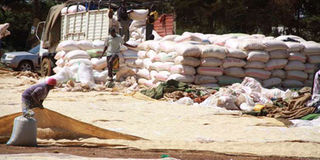October harvest mystery as maize shortfall deepens

Maize in Eldoret on November 28, 2016. PHOTO | JARED NYATAYA | NATION MEDIA GROUP
What you need to know:
With the government and farmers pointing accusing fingers at each other over the current shortage, the answer lies somewhere as Kenyans continue to suffer.
The National Cereals and Produce Board says it had projected the harvest from the country’s food basket at 32 million bags.
The whereabouts of the October maize harvest from the North Rift region is still a mystery as the State mulls importing the grain in order to cushion Kenyans against hunger.
With the government and farmers pointing accusing fingers at each other over the current shortage, the answer lies somewhere as Kenyans continue to suffer.
The National Cereals and Produce Board says it had projected the harvest from the country’s food basket at 32 million bags.
“We only have 1.5 million bags in our reserves so far but we are hoping to get more maize from farmers as time goes by,” the cereals board Managing Director Newton Terer says.
Ideally the Strategic Grain Reserves are supposed to have eight million bags. In September shortly before the North Rift harvest, the cereals board released a million bags out of the three million it had in anticipation of the harvest.
Since then it has slowly been releasing whatever little it has in order to feed hungry Kenyans experiencing drought.
Agriculture Cabinet Secretary Willy Bett recently accused farmers of hoarding maize in anticipation of higher prices, warning them that they will incur losses if they don’t release the grain to the cereals board in order to boost the strategic grain reserves.
'HAVE REFUSED'
“We want farmers to know that we are bringing in maize and whoever is still hoarding will suffer low prices since some of them have refused to release their stocks at the current good prices,” Mr Bett said.
Maize farmers through their umbrella body Kenya Farmers Association maintain that whatever grain they are holding is for consumption by their families since the yield last year was poor but they can only release it if the government adds some incentive.
“For the the CS to threaten farmers is in bad taste because he knows that the country will save more if it buys maize locally in Kenya shillings as opposed to buying it in dollars from abroad,” said the farmers association’s chair Kipkorir arap Menjo.
During the harvest season in October, farmers managed to lobby the government to increase the price that the cereals board would use to buy maize from them from Sh2,500 to Sh3,000 per 90 kilo bag.
This was aimed at preventing farmers from hoarding maize or selling it to millers who have always offered a better price.
The cereals board purchases the grain from farmers and stores it in strategic reserves to sell later whenever there are shortages. When it sets a price, dealers adjust their prices accordingly.
Information from the Regional Agricultural Trade Intelligence Network shows that the wholesale price of a 90 kg bag of maize in Nairobi is currently Sh2,880 – the cheapest in the region. By comparison, the same quantity fetches Sh7,775 in Bujumbura, Sh3,109 in Kampala, Sh2,392 in Kigali and Sh4,586 in Dar es Salaam.
The intelligence network which tracks movement of food products across the borders of East African countries also shows that 1,882 metric tonnes of maize crossed from Uganda to Kenya through the Malaba border this week alone.
FREE MOVEMENT
The East African Common Market protocol allows for duty free movement of maize across the borders. Because of the current drought, all the East African countries have turned to Uganda for rescue.
The farmers’ association, however, says millers are offering better returns to farmers at Sh3,400 per 90 kilo bag of maize. But it maintains that whatever amount of maize they have is not enough to solve the current crisis. “Last year’s crop which is now being consumed faced a lot of challenges and when we raised them no one wanted to talk to us. In totality we had a low yield which in my estimation is about 26 million bags,” says Mr Menjo.
Kenya, a net importer of maize, traditionally depends on Uganda and Tanzania to bridge the gap of about 20 million bags annually. According to the Kenya National Bureau of Statistics, the country harvested 42 million bags of maize in 2015, up from 39 million bags in 2014.
With the current shortfall of about 10 million bags and a biting drought, the government is expected to allow for duty free importation of maize from countries outside East Africa.
HOW MUCH
The Ministry of Agriculture has already indicated that it is in talks with Mexico and a decision will be made in the coming week over how much maize Kenya will import from the country.
In 2008, a shortfall of 11.9 million bags of maize; almost similar to the current situation, forced the Narc government to lift a ban on the importation of the grain. The then government allowed businessmen to import maize to supplement the local produce.
In June last year farmers in the North Rift region complained that the subsidised fertiliser the government had sold to them was causing their crops to wither, adding that this would affect their yields.
They wanted Parliament to investigate whether the NPK fertiliser provided by government had been certified by Kenya Bureau of Standards as it was causing the maize crop to turn yellow after germinating. Nothing concrete came out of the petition despite the police even impounding some of the suspected fertiliser.
KFA says this played a role in contributing to the current crisis.
“When we raised the issue, no one wanted to talk to us but right now everyone is pointing fingers at us,” says Mr Menjo.
Kenya Red Cross has launched an appeal for Sh1 billion in order to help it provide food for people in 12 counties affected by drought.





